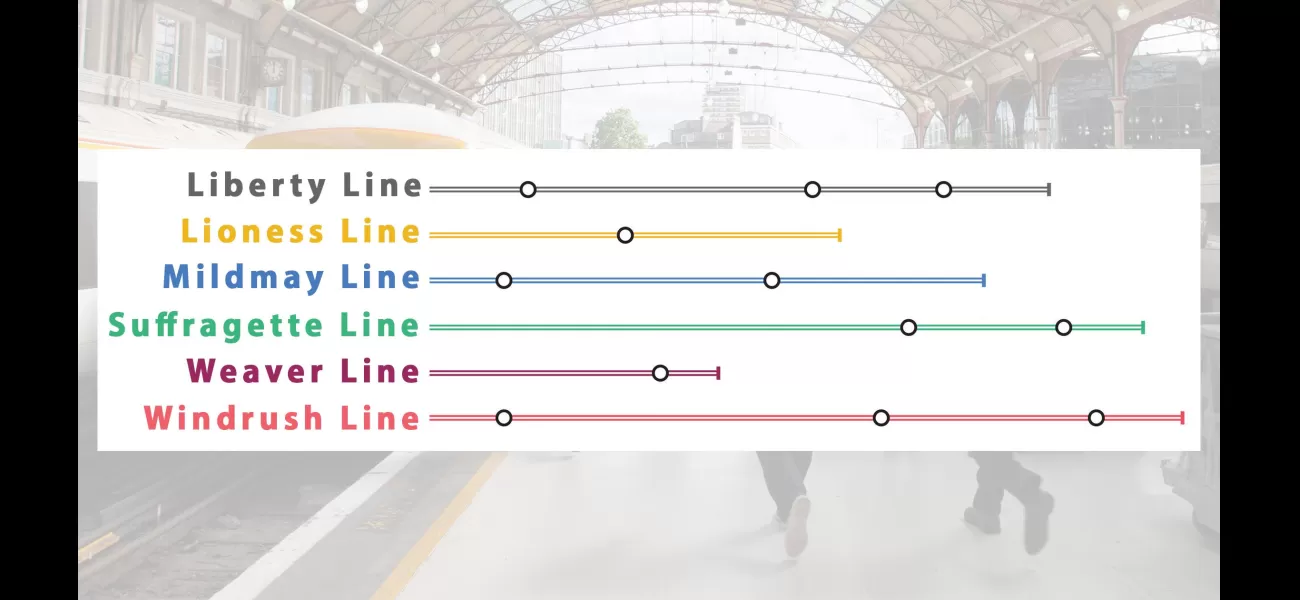The article explains the reason for the new names of London Overground lines and changes to the Tube map.
The new changes to the capital's Tube map will make it more user-friendly and is considered one of the largest updates in its history.
February 15th 2024.

Transport for London has recently announced the new names for the six lines that make up the Overground, as they embark on a major revamp. This exciting change aims to make navigating the network easier for passengers, and it is considered the most significant transformation in the history of London's iconic Tube map.
Spearheaded by Mayor Sadiq Khan, these distinct names were carefully chosen to honor and celebrate the unique local history and culture of different parts of the city. The Overground lines have all been colored orange on the map since 2007, when TfL took over services on four suburban rail lines. However, with the network's expansion over the years, this has resulted in a confusing "mass of orange spaghetti" on maps, making it challenging for some passengers to figure out which train to take.
To address this issue, the renaming of the lines is estimated to cost £6.3 million, which will be funded by Mr. Khan's Greater London Authority budget. The new map and lines will be rolled out later this year, and it is undoubtedly an exciting time for Londoners.
So, what are the new names for the London Overground lines? The six lines will be called Lioness, Mildmay, Windrush, Weaver, Suffragette, and Liberty, and they will be fully implemented in the autumn. However, work has already begun at some stations to rebrand them. Each name has been thoughtfully selected to recognize the areas served by the lines and pay tribute to their rich history and culture.
But why were these names chosen? TfL's main goal was to make navigating the network easier for passengers. To achieve this, they worked closely with customers, stakeholders, historians, industry experts, and local communities to come up with names that truly represent the areas the lines travel through. This revamp was promised by Mayor Sadiq Khan in his 2021 re-election manifesto, expressing his desire for the lines to reflect the capital's diversity.
Let's take a closer look at the meaning behind each new Overground name. The Lioness Line is a tribute to the England women's football team, also known as the Lionesses, who won Euro 2022 at Wembley Stadium, which is served by the line. The Mildmay Line is named after Mildmay Mission Hospital in Shoreditch, a renowned hospital that specializes in HIV-related illnesses. In 1988, its predecessor on the site was Europe's first AIDS hospice, and it reopened as a specialist HIV hospital in 2014.
The Windrush Line is a nod to the Windrush generation, who came to the UK from the Caribbean to fill labor shortages after World War II. This line runs through several communities with strong ties to the Caribbean, such as Dalston Junction, Peckham Rye, and West Croydon. The Weaver Line got its name from its route through areas historically known for the textile trade, including Bethnal Green, Liverpool Street, and Spitalfields.
The Suffragette Line is a tribute to the movement that fought for women's right to vote in the early 20th century. Barking, located at the eastern end of the line, was home to suffragette Annie Huggett, who lived to be 103. Lastly, the Liberty Line is a short line with only three stops, operating separately from the rest of the network. Its name celebrates the concept of independence and links to the history of Havering, which the line runs through, as a self-governing "royal liberty."
The new Overground map follows the same path as the old one, but with clearer labeling thanks to the new line names and colors. Mayor Sadiq Khan expressed his excitement about this transformation, stating that it will make getting around the city simpler and easier for passengers. He also mentioned that this revamp is a way to honor and celebrate the diverse history and culture of London.
But that's not all that TfL has in store for London's transport network. Beginning in spring 2024, the DLR trains will be more spacious, have a walk-through design, and be air-conditioned. The Piccadilly Line will also see new air-conditioned walk-through trains starting in 2025. Furthermore, a new signaling system will be introduced for the Circle, District, Hammersmith & City, and Metropolitan lines to speed up future journeys. And for those who prefer traveling on four wheels, all new buses will have 100% low or zero emissions at the tailpipe. Overall, these changes are set to improve the travel experience for all Londoners, making it a more efficient and sustainable city.
Spearheaded by Mayor Sadiq Khan, these distinct names were carefully chosen to honor and celebrate the unique local history and culture of different parts of the city. The Overground lines have all been colored orange on the map since 2007, when TfL took over services on four suburban rail lines. However, with the network's expansion over the years, this has resulted in a confusing "mass of orange spaghetti" on maps, making it challenging for some passengers to figure out which train to take.
To address this issue, the renaming of the lines is estimated to cost £6.3 million, which will be funded by Mr. Khan's Greater London Authority budget. The new map and lines will be rolled out later this year, and it is undoubtedly an exciting time for Londoners.
So, what are the new names for the London Overground lines? The six lines will be called Lioness, Mildmay, Windrush, Weaver, Suffragette, and Liberty, and they will be fully implemented in the autumn. However, work has already begun at some stations to rebrand them. Each name has been thoughtfully selected to recognize the areas served by the lines and pay tribute to their rich history and culture.
But why were these names chosen? TfL's main goal was to make navigating the network easier for passengers. To achieve this, they worked closely with customers, stakeholders, historians, industry experts, and local communities to come up with names that truly represent the areas the lines travel through. This revamp was promised by Mayor Sadiq Khan in his 2021 re-election manifesto, expressing his desire for the lines to reflect the capital's diversity.
Let's take a closer look at the meaning behind each new Overground name. The Lioness Line is a tribute to the England women's football team, also known as the Lionesses, who won Euro 2022 at Wembley Stadium, which is served by the line. The Mildmay Line is named after Mildmay Mission Hospital in Shoreditch, a renowned hospital that specializes in HIV-related illnesses. In 1988, its predecessor on the site was Europe's first AIDS hospice, and it reopened as a specialist HIV hospital in 2014.
The Windrush Line is a nod to the Windrush generation, who came to the UK from the Caribbean to fill labor shortages after World War II. This line runs through several communities with strong ties to the Caribbean, such as Dalston Junction, Peckham Rye, and West Croydon. The Weaver Line got its name from its route through areas historically known for the textile trade, including Bethnal Green, Liverpool Street, and Spitalfields.
The Suffragette Line is a tribute to the movement that fought for women's right to vote in the early 20th century. Barking, located at the eastern end of the line, was home to suffragette Annie Huggett, who lived to be 103. Lastly, the Liberty Line is a short line with only three stops, operating separately from the rest of the network. Its name celebrates the concept of independence and links to the history of Havering, which the line runs through, as a self-governing "royal liberty."
The new Overground map follows the same path as the old one, but with clearer labeling thanks to the new line names and colors. Mayor Sadiq Khan expressed his excitement about this transformation, stating that it will make getting around the city simpler and easier for passengers. He also mentioned that this revamp is a way to honor and celebrate the diverse history and culture of London.
But that's not all that TfL has in store for London's transport network. Beginning in spring 2024, the DLR trains will be more spacious, have a walk-through design, and be air-conditioned. The Piccadilly Line will also see new air-conditioned walk-through trains starting in 2025. Furthermore, a new signaling system will be introduced for the Circle, District, Hammersmith & City, and Metropolitan lines to speed up future journeys. And for those who prefer traveling on four wheels, all new buses will have 100% low or zero emissions at the tailpipe. Overall, these changes are set to improve the travel experience for all Londoners, making it a more efficient and sustainable city.
[This article has been trending online recently and has been generated with AI. Your feed is customized.]
[Generative AI is experimental.]
0
0
Submit Comment





